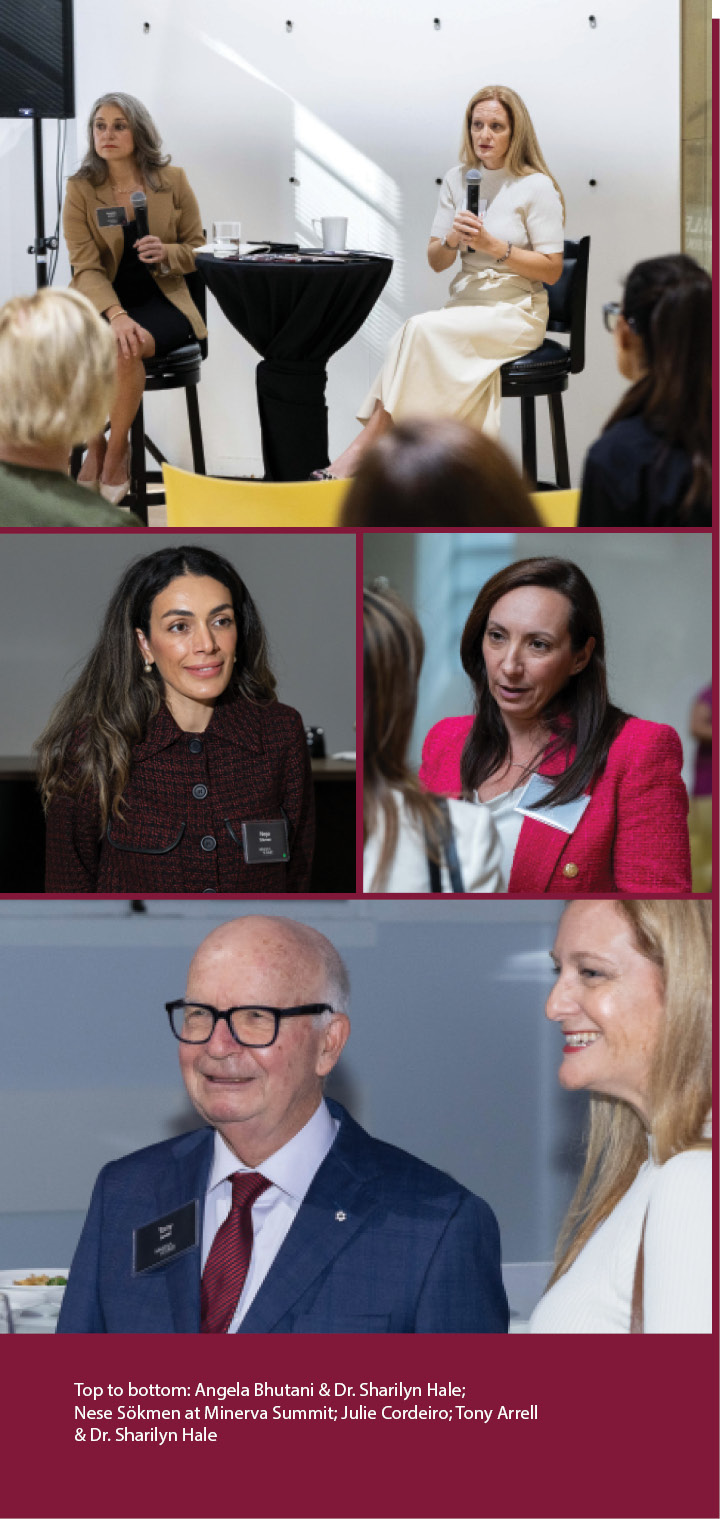What excites you? What inspires you? What breaks your heart? Dr. Sharilyn Hale encourages you to reflect on these questions when selecting the charitable cause that’s right for you. In her conversation with Investment Counsellor Angela Bhutani, Hale highlights key areas for individuals and families to consider when defining their charitable goals, while also discussing the growing influence of women in shaping modern philanthropy.
Angela Bhutani: Why is it important for women to be engaged and thoughtful in philanthropic activity?
Dr. Sharilyn Hale: Women have always been at the forefront of philanthropy, mobilizing for social change through their gifts of money, collective fundraising, and volunteer leadership. We owe a debt of gratitude to the women who came before us and helped shape the communities, practices, and laws we benefit from today. There is more to be done, so it’s more important than ever for philanthropy to be on women’s radars.
Increasingly, women are wealth creators, beneficiaries, and inheritors (often inheriting from their parents or a spouse). They have a growing responsibility for decision-making about how wealth is managed and allocated, increasing their philanthropic capacity and influence which will have a positive impact on society. Recognizing philanthropy is an integral element of one’s overall wealth stewardship, and planning empowers women to explore purposeful uses of their wealth.
“Recognizing philanthropy is an integral element of one’s overall wealth stewardship, and planning empowers women to explore purposeful uses of their wealth.”
I have observed that, for many women, philanthropy also carries the potential to become a meaningful platform as they navigate change and transition in their lives, such as the death of a spouse, a divorce, or the sale of a business. These are moments when we tend to stop and ask: “What is important to me? What does this mean for how I move forward?” Philanthropy can be a path to renewed purpose, meaning, and satisfaction, bringing new dimensions to life and leadership.
AB: Do women approach philanthropy differently than men?
SH: We have research in Canada, supported by research globally, that suggests women participate in philanthropy differently. We tend to be more collaborative in our giving and more connected to our local communities, gravitating towards supporting grassroots, human services, and child-related causes. Women also tend to take longer to make major charitable giving decisions as they prioritize more robust due diligence and developing relationships with the organizations they support.
However, women are not a homogeneous group. Findings from research on women’s philanthropy show variation based on age, ethnicity, education, and the urban/rural divide. Yet, there are broad themes that emerge that help us better support women in their charitable planning and decision-making, and encourage even greater giving and engagement by women.
AB: When embarking on a new philanthropic journey, what is the first question one should ask?
SH: The first question I always start with: “Why?” This anchors your giving in a sense of purpose, which then drives everything else. What is the purpose behind, and for, the giving? What aspirations for giving do you have for yourself, your family, and your community? Where does the desire to give come from, and what values will guide you?
With or without a philanthropy advisor, taking time to reflect on the “why” behind your giving can be inspirational and fun, whether you’re new to formal philanthropy or are a seasoned philanthropist wanting to pivot or deepen your experience. This exploration can result in identifying a mission and vision for your giving, and will help you articulate the values that will inform how you move forward, reach out to others, and make decisions.
AB: Once you have identified the purposes of your giving, what question comes next?
SH: The next question is to figure out the “what.” What do you want to support, and what strategy will get results? Honing in on this can help bring some focus, particularly where there is not an immediate passion or alignment to a particular issue or cause.
For those who want to do good in the world but are unsure about where to focus, I invite them to think about the emotions they experience when they read something online or hear something on the news. What excites you? What inspires you? What breaks your heart? What things make you angry, where you feel a sense of injustice? These responses can provide clues to what matters most to you. When your heart is connected to your giving, it can help overcome feelings of helplessness or of being overwhelmed about the state of the world. You can respond in meaningful ways rather than throwing up your hands in despair. Philanthropy is not only about the giver. The best giving is deeply informed by and responsive to community need and opportunity.
“When your heart is connected to your giving, it can help overcome feelings of helplessness or of being overwhelmed about the state of the world. You can respond in meaningful ways rather than throwing up your hands in despair.”
The second aspect of the “what” is determining what we have to give. We can give our financial treasure, of course, but we can also give our time and our talent—meaning our skills and expertise. We can give our ties, which include our networks or relationships, which may be able to open doors or lead to becoming an ambassador. And we can give our testimony, which involves using our voice and advocating on issues. Understanding the full range of the assets we can harness for good allows us to leverage everything on the table.
 AB: Let’s move to the “who” in our planning. What is it that women and families need to consider?
AB: Let’s move to the “who” in our planning. What is it that women and families need to consider?
SH: Identifying who will be involved in the giving and who will help support the giving is crucial. The “who” could be as simple as defining your philanthropy individually as “mine,” or collectively with a partner or family as “ours.” Both have implications for strategy and decision-making.
“Who?” can be an interesting question for women who are often part of extended ecosystems. Sometimes women can engage in philanthropy in their full power, presence, and personal influence. Other women may be in relationships in which they have little decision-making power or it is difficult to step out of the shadow of a wealth creator. Other women may involve close friends or work within giving circles or collaboratives in their philanthropy.
Families need to ask who will participate in the family’s philanthropy, especially complex and multi-generational families. How do we structure our giving in a way that honours the interests, ages, and life stages of family members? How do we enable family members to be involved in ways that are meaningful for them, while also providing on-ramps and exit ramps so that there is clarity, transparency, and ongoing regeneration and leadership? Families are living, breathing organisms that are always changing—through marriages, births, deaths, and generational change. The more complex the family, the question of who participates, and with what criteria and responsibilities, becomes more important.
The second aspect of the “who” is other expertise that may be needed to support giving well, good decision-making, and strong community connection. Families who give through a private foundation may wish to appoint non-family directors to provide content expertise or to enhance deliberations, they may hire a philanthropy advisor or professional staff, and some may work with advisory councils or community foundation resources.
AB: What about engaging children in philanthropy?
SH: This is often top of mind for women, but also for most parents and grandparents. My belief is that it is never too early to expose children to and involve them in giving activities. I have spoken with countless philanthropists and generous people over the years. Many have shared that their desire to give and be involved in community stemmed from seeds planted early by parents, grandparents, or other influential people in their lives. Involvement needs to be developmentally appropriate, of course, but early experiences can be informative, giving children a glimpse of worlds outside their own and a sense of the responsibility we all have to give and be of service where we can. Even quite young children have the ability to identify ways they can be helpful, kind, and make a difference.
Approached thoughtfully, a family’s philanthropy can also play a role in the wealth education and leadership development of older children and young adults. Having conversations about giving and family values, exploring community issues, participating in organized meetings and decision making, and even learning to construct budgets and read financial statements can be invaluable experiences.
AB: As investment counselors, we are most often involved in the next question—the “how” of giving. What does this entail?
SH: The “how” is the final question that we’re exploring because it is easiest to tackle once you have clarity on the “why,” “what,” and “who.” Conversations around the tactical aspects of giving are often initiated around tax efficiency. We know through research that tax efficiency is not a driving motivation for philanthropy, particularly for women philanthropists, but it is an important consideration. For example, giving appreciated securities is one of the most tax effective ways to make a charitable donation, which allows donors to give more for greater results.
Generous people often have questions about what charitable vehicle will suit them best. Private foundations and donor-advised funds both offer attractive features and benefits, depending on the circumstances of the family, the amount of charitable assets and time they want to invest, and the long-term objectives for the philanthropy. Donor-advised funds have experienced significant growth in Canada in recent years due to their increasing availability and convenience for donors. For other givers, private foundations remain the preferred option. Traditionally, philanthropies were set up to exist in perpetuity, dispersing only a small percent of the assets each year, resulting in growth of the assets over generations. While this remains a common approach, more philanthropists are questioning the merits—as are many in the community sector—with some opting instead to grant charitable assets more quickly or over a defined time frame. All of these decisions benefit from good advice and discussion.
Another element of the “how” that should not be overlooked is learning how to be a great philanthropist and a good charitable partner to organizations that you may support. Charities are wildly diverse in terms of their missions, resources, capacity, and professionalization, but are most often bona fide experts in their areas of work. Have open and candid conversations with the organizations you support to better understand their work and their challenges, and to explore what role you can play to help and not hinder their work. Read what they send you, participate where you can, and meet other supporters. You’re on the same team and working towards the same goals.
These are wonderful ways to build knowledge, develop trust, and strengthen relationships, which will result in better giving and better community impact. It is not about you, but when giving is a meaningful experience, you are going to be even more joyfully generous next time—and that benefits everyone.
This post is presented for illustrative and discussion purposes only. It is not intended to provide investment advice and does not consider unique objectives, constraints or financial needs. Under no circumstances does this post suggest that you should time the market in any way or make investment decisions based on the content. Select securities may be used as examples to illustrate Burgundy’s investment philosophy. Burgundy funds or portfolios may or may not hold such securities for the whole demonstrated period. Investors are advised that their investments are not guaranteed, their values change frequently and past performance may not be repeated. This post is not intended as an offer to invest in any investment strategy presented by Burgundy. The information contained in this post is the opinion of Burgundy Asset Management and/or its employees as of the date of the post and is subject to change without notice. Please refer to the Legal section of this website for additional information.

